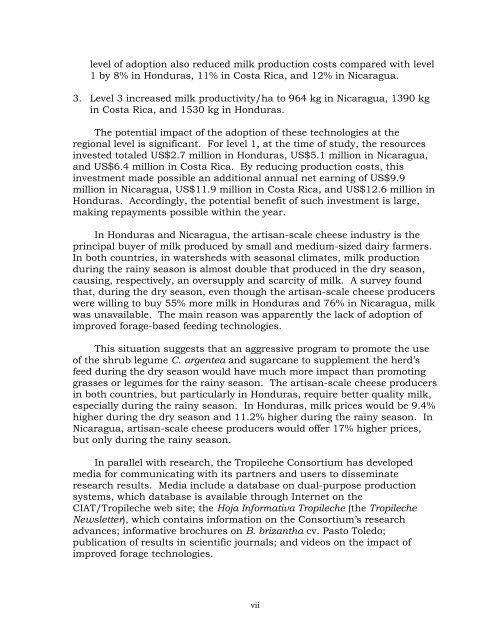Feeding Systems with Legumes to Intensify Dairy Farms - cgiar
Feeding Systems with Legumes to Intensify Dairy Farms - cgiar
Feeding Systems with Legumes to Intensify Dairy Farms - cgiar
You also want an ePaper? Increase the reach of your titles
YUMPU automatically turns print PDFs into web optimized ePapers that Google loves.
level of adoption also reduced milk production costs compared <strong>with</strong> level<br />
1 by 8% in Honduras, 11% in Costa Rica, and 12% in Nicaragua.<br />
3. Level 3 increased milk productivity/ha <strong>to</strong> 964 kg in Nicaragua, 1390 kg<br />
in Costa Rica, and 1530 kg in Honduras.<br />
The potential impact of the adoption of these technologies at the<br />
regional level is significant. For level 1, at the time of study, the resources<br />
invested <strong>to</strong>taled US$2.7 million in Honduras, US$5.1 million in Nicaragua,<br />
and US$6.4 million in Costa Rica. By reducing production costs, this<br />
investment made possible an additional annual net earning of US$9.9<br />
million in Nicaragua, US$11.9 million in Costa Rica, and US$12.6 million in<br />
Honduras. Accordingly, the potential benefit of such investment is large,<br />
making repayments possible <strong>with</strong>in the year.<br />
In Honduras and Nicaragua, the artisan-scale cheese industry is the<br />
principal buyer of milk produced by small and medium-sized dairy farmers.<br />
In both countries, in watersheds <strong>with</strong> seasonal climates, milk production<br />
during the rainy season is almost double that produced in the dry season,<br />
causing, respectively, an oversupply and scarcity of milk. A survey found<br />
that, during the dry season, even though the artisan-scale cheese producers<br />
were willing <strong>to</strong> buy 55% more milk in Honduras and 76% in Nicaragua, milk<br />
was unavailable. The main reason was apparently the lack of adoption of<br />
improved forage-based feeding technologies.<br />
This situation suggests that an aggressive program <strong>to</strong> promote the use<br />
of the shrub legume C. argentea and sugarcane <strong>to</strong> supplement the herd’s<br />
feed during the dry season would have much more impact than promoting<br />
grasses or legumes for the rainy season. The artisan-scale cheese producers<br />
in both countries, but particularly in Honduras, require better quality milk,<br />
especially during the rainy season. In Honduras, milk prices would be 9.4%<br />
higher during the dry season and 11.2% higher during the rainy season. In<br />
Nicaragua, artisan-scale cheese producers would offer 17% higher prices,<br />
but only during the rainy season.<br />
In parallel <strong>with</strong> research, the Tropileche Consortium has developed<br />
media for communicating <strong>with</strong> its partners and users <strong>to</strong> disseminate<br />
research results. Media include a database on dual-purpose production<br />
systems, which database is available through Internet on the<br />
CIAT/Tropileche web site; the Hoja Informativa Tropileche (the Tropileche<br />
Newsletter), which contains information on the Consortium’s research<br />
advances; informative brochures on B. brizantha cv. Pas<strong>to</strong> Toledo;<br />
publication of results in scientific journals; and videos on the impact of<br />
improved forage technologies.<br />
vii
















